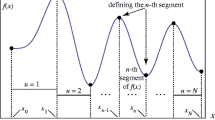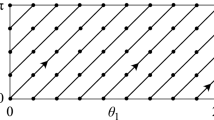Abstract
This paper explores the consequences of discretization of space in quantum mechanics. Specifically, I show that under normal conditions in space where the wave function is uniform across a quantum of space, Heisenberg’s uncertainty principle is identically satisfied, where the “normal conditions” are defined as \(p_x\Delta x/\hbar \ll 1\) with \(\Delta x\) characterizing the size of a quantum of position space or equivalently \(\Delta p_x x/\hbar \ll 1\) with \(\Delta p_x\) characterizing the size of a quantum of momentum space (this limiting behavior is also at the core of Nyquist sampling theorem; see Jerri (1977); Vaidyanathan (IEEE Trans. Circ. Syst. I Fundam. Theory Appl. 48(9), 1094–1109, 2001); Ozaktas et al. (2001)). Moreover, I derive an equation similar to Heisenberg’s uncertainty principle which imposes a constraint on the minimum values of “precision” of space (i.e. the maximum values for \(\Delta x\) and \(\Delta p_x\)). Additionally, I show that in discretized space the simultaneous minimum position and minimum momentum uncertainties are unphysical.
Similar content being viewed by others
References
Ali, A.F., Das, S., Vagenas, E.C.: Discreteness of space from the generalized uncertainty principle. Phys. Lett. B 678(5), 497–499 (2009)
Bang, J.Y., Berger, M.S.: Quantum mechanics and the generalized uncertainty principle. Physical Review D. 74(12), 125012 (2006)
Gambini, R., Pullin, J.: Consistent discretization and loop quantum geometry. Phys. Rev. Lett. 94(10), 101302 (2005)
Amelino-Camelia, G.: Testable scenario for relativity with minimum length. Phys. Lett. B 510(1–4), 255–263 (2001)
Tarasov, V.E.: Exact discretization of Schrödinger equation. Phys. Lett. A 380(1–2), 68–75 (2016)
Jerri, A.J.: The Shannon sampling theorem-Its various extensions and applications: A tutorial review. Proc. IEEE 65(11), 1565–1596 (1977)
Vaidyanathan, P.P.: Generalizations of the sampling theorem: Seven decades after Nyquist. IEEE Trans. Circ. Syst. I Fundam. Theory Appl. 48(9), 1094–1109 (2001)
Ozaktas, H.M. and Kutay, M.A.: The fractional Fourier transform. 2001 European Control Conference (ECC). (2001). IEEE
Funding
The author declares that no funds, grants, or other support were received during the preparation of this manuscript.
Author information
Authors and Affiliations
Contributions
All analysis was performed by Andrii Hopanchuk (the author of the paper).
Corresponding author
Ethics declarations
Competing Interests
The author has no relevant financial or non-financial interests to disclose.
Additional information
Publisher's Note
Springer Nature remains neutral with regard to jurisdictional claims in published maps and institutional affiliations.
Appendix
Appendix
In this section I will prove two results I previously used.
1) Here a method of Lagrange multiplier is used to show that the minimum uncertainty wave function is
And the maximum uncertainty wave function is
Suppose the coordinate system is chosen such that \(\langle {x}\rangle =0\). The constrain function is \(g(|\Psi _{-N-1}|,\dots ,|\Psi _N|)=(|\Psi _{-N-1}|^2+\dots +|\Psi _N|^2)\Delta x-1\) and the objective function is \(f(|\Psi _{-N-1}|,\dots ,|\Psi _N|)=\sum _{i}((i+\frac{1}{2})^2 +\frac{1}{12})\Delta x^2|\Psi _i|^2\Delta x\). Then \(\nabla g = [|\Psi _{-N-1}|,\dots ,|\Psi _N|]2\Delta x\) and \(\nabla f = 2\Delta x^3[(-N-\frac{1}{2})^2|\Psi _{-N-1}|,\dots ,((N+\frac{1}{2})^2+\frac{1}{12})|\Psi _N|]\). One \(\Psi \) that maximizes f is \(\Psi _i=\frac{1}{\sqrt{\Delta x}}\left[ \frac{1}{\sqrt{2}}\delta _{i(-N-1)}+\frac{1}{\sqrt{2}}\delta _{iN}\right] \) because it satisfies g and satisfies \(\lambda \nabla g = \nabla f\) \(\forall i\). First I will show \(\lambda \nabla g = \nabla f\) is satisfied for \(i=-N-1\)
So, \(\lambda =((-N-\frac{1}{2})^2+\frac{1}{12}) \Delta x^3\). In order for \(\lambda \nabla g = \nabla f\) to be satisfied for \(i=N+1\) this lambda has to also equal to \(((N+\frac{1}{2})^2+\frac{1}{12})\Delta x^3\) (and it does).
The rest are satisfied because both sides of \(\lambda \nabla g = \nabla f\) are zero. Other \(\Psi \) of similar form that satisfy \(\lambda \nabla g = \nabla f\) are local maxima because they will be distributed closer to \(\langle {x}\rangle =0\) and thus have lower variance.
Similarly, one \(\Psi \) that minimizes f is \(\Psi _i = \frac{1}{\sqrt{\Delta x}}\delta _{i0}\) because it satisfies g and \(\lambda \nabla g = \nabla f\) if \(\lambda =\Delta x^2(\frac{1}{12})\).
Other \(\Psi \) that may satisfy Lagrange equation will be distributed further from \(\langle {x}\rangle \) and thus have a higher variance.
2) A method of Lagrange multiplier is used to show that \(\sum _k|\Psi _{k11}|\sqrt{\Delta x}\le \sum _k\frac{1}{\sqrt{N}}=\frac{N}{\sqrt{N}}\). Suppose the objective function to be maximized is \(f(|\Psi _1|,\dots ,|\Psi _1|)=|\Psi _1|+\dots +|\Psi _N|\). The constraint function is \(g(|\Psi _1|,\dots ,|\Psi _1|)=|\Psi _1|^2+\dots +|\Psi _N|^2-1\). Then \(\nabla f=[1,\dots ,1]=\frac{\sqrt{N}}{2}[2|\Psi _1|,\dots ,2|\Psi _N|]=\frac{\sqrt{N}}{2}\nabla g\), which implies \(|\Psi _i|=\frac{1}{\sqrt{N}}\)
Rights and permissions
Springer Nature or its licensor (e.g. a society or other partner) holds exclusive rights to this article under a publishing agreement with the author(s) or other rightsholder(s); author self-archiving of the accepted manuscript version of this article is solely governed by the terms of such publishing agreement and applicable law.
About this article
Cite this article
Hopanchuk, A. Space Discretization in Quantum Physics and Precision Principle. Int J Theor Phys 62, 230 (2023). https://doi.org/10.1007/s10773-023-05490-x
Received:
Accepted:
Published:
DOI: https://doi.org/10.1007/s10773-023-05490-x




